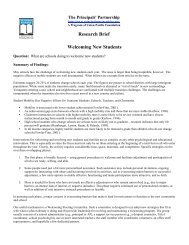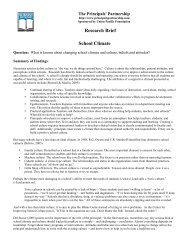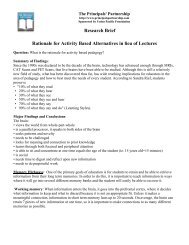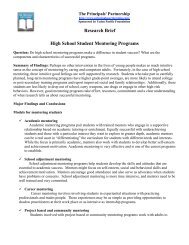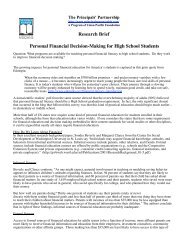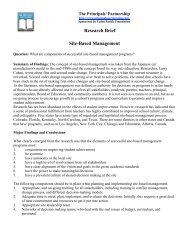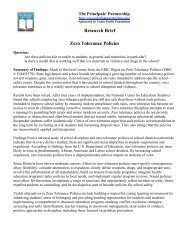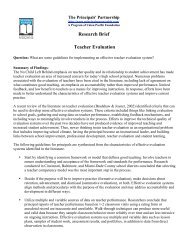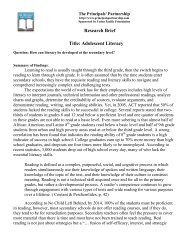Research Brief School-Home Partnerships - Online Effectiveness ...
Research Brief School-Home Partnerships - Online Effectiveness ...
Research Brief School-Home Partnerships - Online Effectiveness ...
Create successful ePaper yourself
Turn your PDF publications into a flip-book with our unique Google optimized e-Paper software.
The Principals' Partnership<br />
http://www.principalspartnership.com/<br />
Sponsored by Union Pacific Foundation<br />
<strong>Research</strong> <strong>Brief</strong><br />
<strong>School</strong>-<strong>Home</strong> <strong>Partnerships</strong><br />
Question: What are components of successful home-school partnerships that involve parents<br />
Summary of Findings: Does parent involvement in school affect student achievement Synthesis of data<br />
collected from schools that have been involved in the National Network of Partnership <strong>School</strong>s appeared to<br />
indicate that regardless of the student's socioeconomic and/or ethnic background, when parents are involved<br />
at home and in school, there is a positive effect on the student's grades, attendance, and behavior. The most<br />
dominant and comprehensive model for parent involvement seemed to come from Joyce Epstein out of Johns<br />
Hopkins in Baltimore, Maryland.<br />
Major Findings and Conclusions:<br />
1. There are 6 distinct types of parent involvement in the Epstein model (more detail to follow).<br />
2. Administration should meet with faculty and staff to obtain feedback on ways in which parents can<br />
effectively be utilized and engaged in the school and its programs. Faculty and staff will need on-going<br />
training, support, and guidance.<br />
3. Leadership from the faculty, parents, and students should be solicited. They will be responsible for the<br />
initial recruiting efforts. One parent or perhaps with a co-chair, should be the coordinator of the overall<br />
program.<br />
4. For each type of involvement, an action team should be established. They will design, implement, and<br />
evaluate a short term, 1 year, and long-term, 3-5 years, action plans. These plans should be developed<br />
around the needs of the students and the school's goals.<br />
5. Funding for the program should be in place.<br />
6. As much as is realistic and feasible, all communication should be in the dominant language(s) of the<br />
school's population.<br />
7. Allow time for the program to grow and take hold. It usually takes three to five years for a program to<br />
become an integral part of the culture.<br />
Epstein Model:<br />
Type 1:<br />
Type 2:<br />
Parenting: How can parents be effectively and actively engaged with their student at home and<br />
school This can be done through a frequent newsletter. Notes, emails, and/or voice mail can be<br />
sent by specific teachers regarding assignments, due dates, and suggestions for parents in ways<br />
they can provide assistance. Workshops based on parent interests can be held at places throughout<br />
the community, not just at the school.<br />
Communicating: How is the school communicating with parents to inform them about its<br />
schedule, its activities, and programs Some suggestions: newsletters mailed home through US<br />
mail; prerecording at the school; parent conferences; report card pick up night; brochures in<br />
different businesses and medical offices throughout the district; translating any communication
The Principals' Partnership<br />
http://www.principalspartnership.com/<br />
Sponsored by Union Pacific Foundation<br />
<strong>Research</strong> <strong>Brief</strong><br />
Type 3:<br />
Type 4:<br />
Type 5:<br />
Type 6:<br />
into the parents' home language(s); and assignment books with descriptions of activities and dates<br />
listed.<br />
Volunteering: How can parents support the school through volunteering<br />
Many parents work during the time that school is in session and want to help; how is the school<br />
inviting them to assist Some ideas include: chaperoning a trip, dance, or other special activity;<br />
recording books on tape; participating in special school beautification projects such as gardening<br />
or painting; donating materials and/or supplies; supporting teachers through completing tasks at<br />
home such as preparing bulletin board, art, and/or science materials; establishing a volunteer<br />
room that is well supplied with materials so that parents can support teachers' needs, and<br />
brochures about the school, community services, adult education classes, to work with a student<br />
or small group of students; to speak with a class about a specific career and/or; and to arrange for<br />
a group of students to visit a particular business or place of interest.<br />
Learning at home: Given the complexity of some of the content that students take, what can<br />
parents do to help and support their student at home Some ideas are: teachers send home<br />
information through a note, email, and/or voice mail on expectations, due dates, and some<br />
specific suggestions and ideas on the concept; mini-guidelines can be designed and made<br />
available for parents; workshops on a specific topic can be offered at different locations in the<br />
community; and general information can be sent home in a newsletter.<br />
Decision making: How are parents involved in the actual decision making of the programs that<br />
directly affect their child Some suggestions are: inviting parents' input through surveys mailed<br />
home and/or emailed; meeting with parents in small groups, off site, to solicit ideas, suggestions,<br />
opinions and support; inviting parent representatives to become part of the school's leadership<br />
team; and having a parent be part of interview panels.<br />
Collaborating with the community: How is the community a vital part of the school community<br />
How is the school contributing to the community Some avenues to explore are: making personal<br />
contacts with local businesses and community agencies and services; establishing mutually<br />
beneficial partnerships where students are making valuable contributions to the organization; and<br />
utilizing parent resources to gain entrée into businesses and community agencies.<br />
<strong>Online</strong> Resources:<br />
• Building <strong>Partnerships</strong> to Welcome Middle and High <strong>School</strong> Families<br />
Descriptions of successful ice cream socials and report card pick up events for secondary parents<br />
where they were given information about the school, its programs, tutoring information, and<br />
volunteering opportunities, where parents were able to participate in theme related workshops is<br />
presented.<br />
http://www.csos.jhu.edu/p2000/Middle_and_High/type2school-reports/MHreport_no12.htm<br />
• Center on <strong>School</strong>, Family, and Community <strong>Partnerships</strong><br />
A description of this association and how to get more information about it.<br />
http://www.csos.jhu.edu/p2000/center.htm
The Principals' Partnership<br />
http://www.principalspartnership.com/<br />
Sponsored by Union Pacific Foundation<br />
<strong>Research</strong> <strong>Brief</strong><br />
• Family-Education <strong>Partnerships</strong><br />
This provides links to numerous sites that have different components of parent involvement in<br />
education.<br />
http://www.thefamilyworks.org/Resources/Links.htm<br />
• Family <strong>Partnerships</strong> with high schools: The parents' perspective<br />
This abstract describes an analysis done on 6 schools from rural to urban to suburban. The findings<br />
were consistent that when schools provide opportunities for meaningful partnership programs,<br />
regardless of socioeconomic backgrounds, there is a better chance to ascertain support and<br />
involvement from parents at home and school.<br />
http://www.csos.jhu.edu/crespar/techReports/Report32.pdf<br />
• High <strong>School</strong> Partnership Programs Increase Family Involvement and Student Success<br />
Using Epstein's six types of involvement, how parent partnerships affect student success are<br />
examined. Several ideas for reaching out to parents are included.<br />
http://www.csos.jhu.edu/p2000/type2/issue10/ttype2j4.htm<br />
• National Association of Partners in Education<br />
A description of this association and how to get more information about it.<br />
http://www.napehq.org/<br />
• National Network of Partnership <strong>School</strong>s<br />
A description of this association and how to get more information about it.<br />
http://www.csos.jhu.edu/p2000/<br />
• Network Members Report Low Costs for Quality Partnership Programs<br />
Where funding for partnerships is built into budgets, these seemed to be more solid quality<br />
partnerships. A brief description of the types of funds that have been used to support partnerships is<br />
provided.<br />
http://www.csos.jhu.edu/p2000/partnership_awards/2003/<strong>Research</strong>/type2_research_briefs/ttype2g8.ht<br />
m<br />
• Partnership for Family Involvement in Education<br />
This site provides the access to sign up to receive information on family involvement. This is also a<br />
gateway to other sites for articles and information.<br />
http://www.thefamilyworks.org/Partners/PartFaIn.old.htm
The Principals' Partnership<br />
http://www.principalspartnership.com/<br />
Sponsored by Union Pacific Foundation<br />
<strong>Research</strong> <strong>Brief</strong><br />
• Technology as a Tool for Increasing Communication<br />
This article briefly describes the use of technology to open up more and varied forms of<br />
communication with families.<br />
http://www.thefamilyworks.org/Partners/techcomm.htm<br />
• Type 2 National Network of Partnership <strong>School</strong>s<br />
This newsletter is full of outstanding ideas for partnership programs. As a valuable reference list, it<br />
includes a list of schools around the nation that are members of this organization.<br />
http://www.csos.jhu.edu/p2000/type2.htm<br />
Journals/Periodicals<br />
• Dodd, A. W. (1999, February). How parents and students can enrich the work of a community of<br />
learners. NASSP Bulletin, V. 83, N. 604, p. 18-26.<br />
The importance of working closely with parents and students when making program decisions is<br />
explored in this article.<br />
• Walker, K. (2003, Fall). Putting the pieces together: Parent involvement, is it P.I.E. in the Sky Ohio<br />
Middle <strong>School</strong> Journal, V. 28, N. 1, p. 15-21.<br />
This article describes a parent involvement program following Epstein's model at a middle school in<br />
Ohio. It provides an overview of the parent involvement program prior to implementation and ideas for<br />
various activities to engage parents and community in the school.<br />
Submitted By: Dr. Karen Walker, University of Maine, Farmington<br />
http://www.principalspartnership.com/<br />
This is provided as a service to educators by The Principals Partnership and Union Pacific Foundation, neither of which assumes any responsibility for the content<br />
of the brief or the positions taken by the authors or the Web sites or other authors whose works are included. This research brief reflects information currently<br />
available and is not the official position of The Principals Partnership or Union Pacific Foundation.<br />
Disclaimer: All URLs listed in this site have been tested for accuracy, and contents of Web sites examined for quality, at the time of addition. Content accuracy and<br />
appropriateness, however, cannot be guaranteed over time as Web sites and their contents change constantly. The author takes no responsibility for difficulties<br />
which may result from the use of any Web site listed herein. Please notify the Webmaster if you find any dead links or inappropriate material.<br />
Permission: You may use or download content for research or educational purposes, or for your personal, noncommercial purposes, provided you keep unchanged<br />
all copyright and other notices with them. No other use of any content is permitted. You agree that you will make only lawful use of this research brief, and will<br />
only use these briefs in compliance with all federal, state and local laws and regulations. You agree that you will make no use of the research that violates anyone<br />
else's rights, including copyright, trademark, trade secret, right of privacy, right of publicity or other rights.



